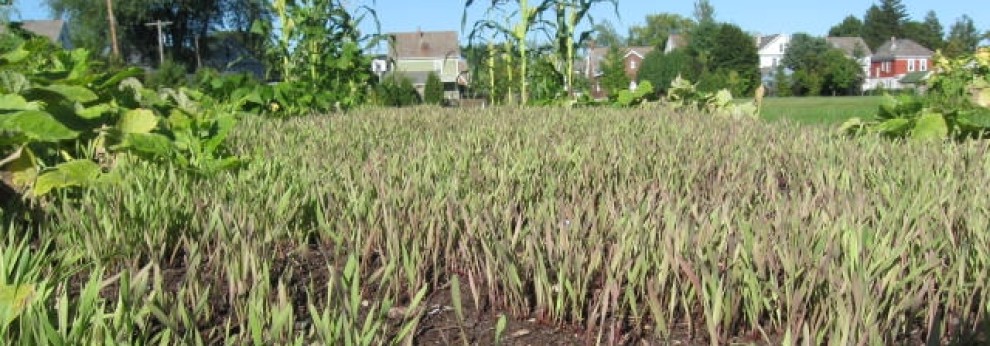 The first group of eighth graders to visit our garden at Myers Middle School on Wednesday had to cross quite an expanse of very wet grass to reach the tomatoes and potatoes and other fare we wanted to show them. Buckets of rain fell late Tuesday. And the footbridge that usually provides the shortest path from the school to the garden is closed for urgent repairs.
The first group of eighth graders to visit our garden at Myers Middle School on Wednesday had to cross quite an expanse of very wet grass to reach the tomatoes and potatoes and other fare we wanted to show them. Buckets of rain fell late Tuesday. And the footbridge that usually provides the shortest path from the school to the garden is closed for urgent repairs.
Footwear definitely got wet. And some students minded.
All of the students, however, got, at minimum, a few minutes of the great powerful health-giving forces known as fresh air and nature. Many of the students availed themselves of opportunities to touch and taste and appeared to enjoy these opportunities very much. And we suspect that many students took a step on a journey to appreciating that footwear does dry.
We partnered Wednesday with Larry Drew, veteran family and consumer science teacher, as we have for years, to bring five classes totally about 100 kids out to the garden. It was great to join with him again. The footing did improve as they day went along. And maybe more importantly, we are building capacity to lead more classes on touch-and-taste walk-arounds than ever. We took six classes and about 75 students out to our Albany High School garden on Friday. And we will partner with classroom teachers throughout the year to build teaching and learning and doing and touching and tasting and experiencing.
But why? Well, the mainstream education program, does not reflect understanding of how vital exposure to nature is to healthy human development. We see no indication that it’s on the state Education Department’s agenda. It doesn’t seem to be on teacher training programs’ radar. School districts, even during the Covid pandemic, made little effort to harness the relative safety of gathering outdoors to facilitate in-person teaching.
All-indoor teaching all of the time may not be the cause of widespread student disengagement, but it certainly leaves schools without useful one path to capturing the attention of students who are not motivated by sitting still in a desk and looking up at the front of the room.
Worse yet, access to the health-giving powers of fresh air and nature are not equitably distributed. Quite simply, students whose families have greater financial resources take more vacations to the seashore than students from poorer households. They are more likely to attend summer camps that revolve around swimming and other outdoor recreation. They are more likely to live in homes with ample yards and in neighborhoods with generous tree canopies.
We don’t offer a panacea in the great achievement gap challenge facing urban schools. Still, the surprise and quick shift from standoffishness to inquisitive that we see time and again, leave little doubt that touching and tasting in our gardens on Wednesday and Friday helped some students appreciate the wonderful opportunities offered by hands-on teaching and learning.
And the couple of grumbles we heard about getting shoes and sneakers wet really didn’t last long at all.
–Bill Stoneman



